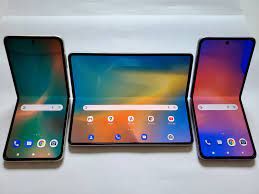The History of Samsung’s Foldable Galaxy Z Series Phones

Samsung, one of the leading smartphone manufacturers in the world, has always been known for its innovative technologies and cutting-edge designs. Among the many notable milestones in the company’s history, the introduction of the Galaxy Z series of foldable phones stands out as a significant achievement. The development of this series of smartphones took years of research and development, testing, and refining of design concepts. Here is a brief history of Samsung’s foldable Galaxy Z series of phones:
2011-2012: The Beginning of Samsung’s Foldable Phone Journey
Samsung first introduced the concept of a foldable phone back in 2011, with a prototype device that featured two screens connected by a hinge. Then, in 2012, the company filed a series of patents for foldable phone designs, which included different types of bending and folding mechanisms.
2013-2016: Galaxy Round and Galaxy Edge
Samsung continued its research and development on foldable phone designs and released its first curved-screen smartphone, the Galaxy Round, in 2013. The device’s display curved slightly around the edges, giving users a unique design and a more immersive experience.
In 2014, Samsung released the Galaxy Note Edge, which was devoid of the Round’s curved shape and featured a screen that wrapped around one side of the device. The Edge’s design took the tech market by storm, and it became so popular that Samsung continued incorporating Edge displays with its Galaxy S series phones in the coming years.
2017-2018: The First Foldable Prototypes
In 2017, Samsung introduced a new prototype foldable phone design that had a folding screen. The prototype had a hinge in the middle, allowing it to fold in half like a flip phone, but instead of having a physical keyboard on one side, it featured a full touchscreen display.
The following year, Samsung unveiled the Galaxy Fold, the world’s first foldable phone with a flexible display. It had a large 7.3-inch screen that could fold in half horizontally, transforming the phone into a more compact device that could fit into a pocket. Although the Galaxy Fold’s launch was initially delayed due to issues with the screens, it eventually hit the market and was well-received by customers and critics alike. Its innovative design made it one of the most highly sought-after smartphones, and Samsung quickly began working on the next iteration.
2019-2020: The Galaxy Z Flip and Galaxy Z Fold 2
In 2020, Samsung released two new Galaxy Z series phones: The Galaxy Fold 2 and the Galaxy Z Flip. The Fold 2 featured an improved folding mechanism and larger screen, while the Z Flip showcased a new smaller, clamshell-style design.
The Z Flip, in particular, marked a significant milestone in Samsung’s foldable phone history, as it was the first foldable smartphone with a folding glass display. This new technology made the Z Flip more durable and scratch-resistant than its predecessors and helped establish Samsung as a true leader in the foldable phone market.
2021: The Future of Galaxy Z
As Samsung continues to push the boundaries of smartphone technology, the Galaxy Z series of foldable phones is expected to remain a crucial part of the company’s product lineup in the future. With each new release, Samsung has managed to improve upon its foldable designs, bringing more innovation, durability, and convenience to its customers.
In conclusion, Samsung’s Galaxy Z series of foldable phones has come a long way since the company’s first prototype back in 2011. From the Galaxy Round and Galaxy Edge to the Galaxy Fold, Galaxy Z Flip and Galaxy Z Fold 2, Samsung has demonstrated its commitment to innovation and design excellence. As the company continues to explore new technologies and perfect the foldable phone concept, we can only expect more remarkable devices from it in the future.






